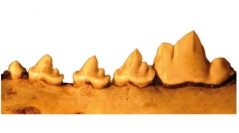

 Comptes Rendus Palevol
7 (8) - Pages 629-643
Comptes Rendus Palevol
7 (8) - Pages 629-643Paleoanthropologists have hypothesized that, during the evolution of increased carnivory in our lineage, hominins transitioned through a scavenging niche created by certain carnivoran taxa (especially sabertooths) that may have lacked the morphology necessary to utilize all parts of carcasses, thus leaving an open niche of high-quality scavengable remains. In this article, we examine the postcanine dentition of modern and fossil carnivorans using quantifications of occlusal radii-of-curvature (ROC) and correlate this morphology with feeding behavior to deduce the carcass-processing capabilities of the Plio-Pleistocene carnivores of South Africa. ROC data do a good job of separating taxa by dietary category, revealing possible differences in the carcass-processing abilities of fossil and modern members of some extant species, and confirming that Chasmaporthetes was probably a hypercarnivore and not a durophage like the modern hyenas. Contrary to previous hypotheses, sabertooth felids do not appear to have been more hypercarnivorous than modern felids based on these data.
Hominin, Hominid, Scavenging niche, Sabertooth, Chasmaporthetes, Durophage, Hypercarnivore